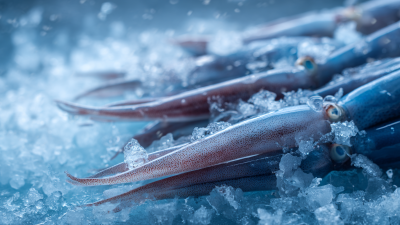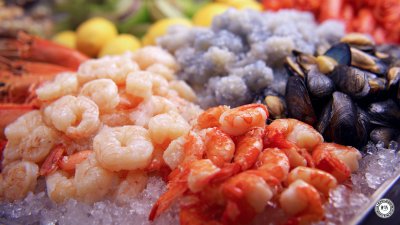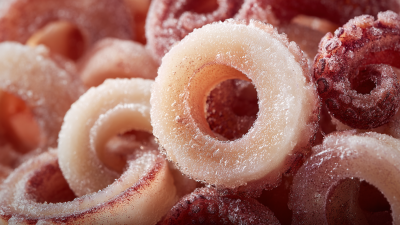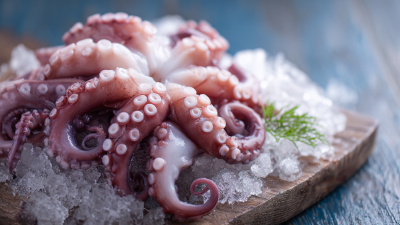In the realm of frozen seafood, the "Kami Frozen Squid Ring" has emerged as a favorite among both home cooks and professional chefs. According to the latest industry report by Seafood Insights, the frozen squid market is projected to grow by 4.5% annually, with squid rings making up a significant portion of this increase due to their versatility and texture. Notably, culinary expert Dr. Lisa Chen emphasizes the appeal of squid rings, stating, "The perfect crispy texture of a well-cooked Kami Frozen Squid Ring can elevate any dish, making it more than just an appetizer."

As the demand for high-quality frozen seafood continues to rise, the importance of mastering cooking techniques at home cannot be overstated. The ability to replicate the restaurant-quality crunch of Kami Frozen Squid Rings is now within reach for home chefs, who can take advantage of innovative cooking methods to achieve that perfect balance of crunch and flavor. Embracing this culinary journey not only enhances meal experiences but also promotes sustainable seafood consumption, as highlighted in the latest sustainability report from Ocean Wise. With the right recipe at hand, creating delicious, crispy squid rings at home is more achievable than ever.
The frozen seafood market has witnessed significant growth in 2023, driven by rising consumer awareness of health benefits associated with seafood and the growing demand for convenient meal options. According to a report by Mordor Intelligence, the global frozen seafood market is expected to grow at a compound annual growth rate (CAGR) of 5.3%, reaching a market value of approximately $60 billion by 2027. This surge is largely attributable to busy lifestyles that prompt consumers to seek quick, nutritious meal solutions without sacrificing quality.
In addition to convenience, sustainability has emerged as a key trend influencing purchasing decisions. A recent survey conducted by the Seafood Nutrition Partnership highlighted that 71% of consumers are willing to pay more for sustainably sourced seafood. This trend not only reflects a shift in consumer values but also prompts seafood producers to adapt their practices to meet these demands. As frozen seafood, including products like crispy kami frozen squid rings, gains popularity, it’s imperative for brands to emphasize sourcing transparency and sustainability in their marketing strategies to capture the increasingly eco-conscious consumer market.
This chart illustrates the market growth percentages of various frozen seafood products in 2023, highlighting the rising popularity and demand for frozen squid rings among consumers.
When it comes to achieving perfectly crispy squid rings at home, selecting the right ingredients is crucial. Start with fresh squid, ideally rings cut from larger squid rather than frozen pre-packaged options. For that irresistible crunch, a mix of all-purpose flour and cornstarch creates a light yet crispy coating. You might also consider adding a pinch of seasoning to the flour mixture, such as paprika or garlic powder, to elevate the flavor profile.
Tips: To enhance the crispiness, ensure that your oil is hot enough before frying—around 350°F (175°C) is ideal. This prevents the squid from absorbing too much oil and becoming greasy. Additionally, work in small batches; overcrowding the pan can lower the oil temperature and lead to soggy rings. Once fried, drain the squid rings on paper towels to remove excess oil and serve immediately for the best texture. Enjoy your homemade crispy kami frozen squid rings as a delightful appetizer or a tasty snack!
To achieve restaurant-quality crispy Kami frozen squid rings at home, the key lies in mastering the cooking techniques. First, it's essential to choose the right coating that will enhance the texture. A combination of seasoned flour and cornstarch can create a light, crispy exterior. Dredging the squid rings in this mixture before frying will ensure that they are well-coated, adding to the crunchiness. For an extra layer of flavor, consider incorporating spices like paprika or garlic powder into the coating.
Next, the frying temperature is crucial. Preheat your oil to around 350°F (175°C) for optimal frying. If the oil is too cold, the squid rings will absorb excess oil, becoming greasy rather than crispy. Fry the squid rings in small batches to maintain the oil temperature, and cook for just a few minutes until they turn golden brown. Draining them on a wire rack instead of paper towels will help retain their crispiness, allowing air to circulate around the rings. With these techniques, you'll be able to recreate that delightful crunch and tenderness characteristic of high-quality squid rings, right from the comfort of your kitchen.
Squid is not only a popular delicacy enjoyed in various cuisines but also offers a wealth of health benefits that are often overlooked. Rich in protein, low in calories, and packed with essential nutrients, squid should be a staple in any balanced diet. According to the United States Department of Agriculture (USDA), a 3-ounce serving of cooked squid contains approximately 15 grams of protein and only 84 calories, making it an excellent source of lean protein for those aiming to maintain or lose weight.
Furthermore, squid is abundant in omega-3 fatty acids, which are vital for heart health. A significant body of research indicates that these fatty acids can reduce inflammation and lower the risk of chronic diseases such as heart disease and arthritis. Additionally, squid is a source of essential minerals like selenium, zinc, and vitamin B12, which play crucial roles in metabolism and immune function. The Nutritional Research Reviews journal highlights that a diet inclusive of seafood can improve cognitive function and support overall wellness, emphasizing the importance of consumer awareness regarding the nutritional value of seafood, including squid.
Sustainability in seafood sourcing is increasingly imperative in today’s market, particularly when it comes to frozen squid products. According to a report by the Food and Agriculture Organization (FAO), approximately 34% of the world's fish stocks are overfished, highlighting the urgent need for responsible sourcing. When selecting frozen squid, consumers can prioritize products that are certified by organizations such as the Marine Stewardship Council (MSC) or the Aquaculture Stewardship Council (ASC). These certifications ensure that the seafood comes from sustainable, well-managed fisheries that minimize environmental impact and support ecosystem health.
Additionally, a recent industry analysis by Global Seafood Alliance emphasizes the growing consumer preference for transparency in sourcing practices. Nearly three-quarters of seafood consumers are now seeking out brands that provide information about their sourcing methods. This shift drives companies to adopt best practices, such as traceability and eco-labeling, allowing consumers to make informed choices that align with their values. By opting for sustainably sourced frozen squid, home cooks can enjoy delicious recipes like crispy kami squid rings while supporting the health of our oceans and promoting sustainable fishing practices.
| Attribute | Details |
|---|---|
| Product Name | Crispy Frozen Squid Rings |
| Main Ingredient | Squid |
| Source Location | Sustainable Fisheries Worldwide |
| Sustainability Certification | MSC Certified |
| Recommended Cooking Method | Frying |
| Cooking Time | 3-5 minutes |
| Serving Suggestions | Serve with tartar sauce and lemon wedges |
| Nutritional Information (per 100g) | Calories: 200, Protein: 14g, Fat: 15g, Carbs: 6g |






